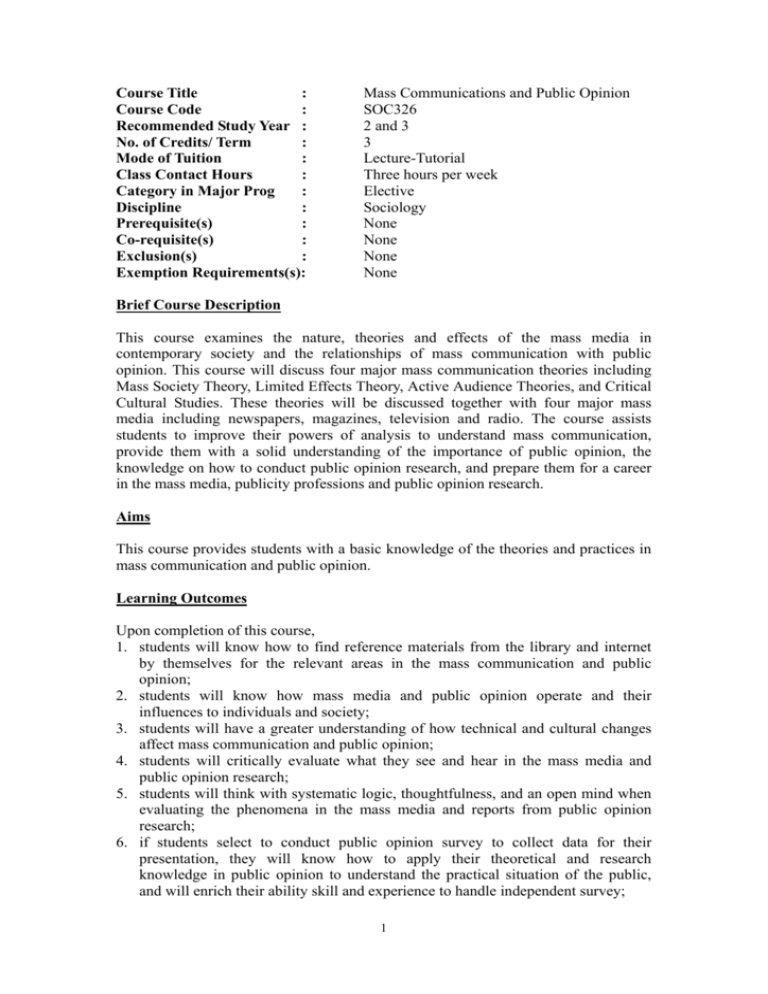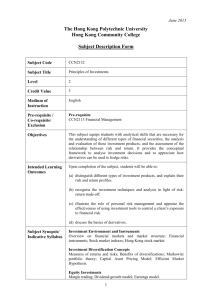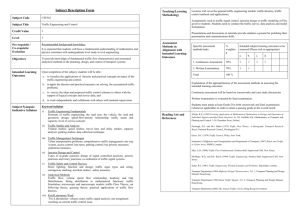SOC326
advertisement

Course Title : Course Code : Recommended Study Year : No. of Credits/ Term : Mode of Tuition : Class Contact Hours : Category in Major Prog : Discipline : Prerequisite(s) : Co-requisite(s) : Exclusion(s) : Exemption Requirements(s): Mass Communications and Public Opinion SOC326 2 and 3 3 Lecture-Tutorial Three hours per week Elective Sociology None None None None Brief Course Description This course examines the nature, theories and effects of the mass media in contemporary society and the relationships of mass communication with public opinion. This course will discuss four major mass communication theories including Mass Society Theory, Limited Effects Theory, Active Audience Theories, and Critical Cultural Studies. These theories will be discussed together with four major mass media including newspapers, magazines, television and radio. The course assists students to improve their powers of analysis to understand mass communication, provide them with a solid understanding of the importance of public opinion, the knowledge on how to conduct public opinion research, and prepare them for a career in the mass media, publicity professions and public opinion research. Aims This course provides students with a basic knowledge of the theories and practices in mass communication and public opinion. Learning Outcomes Upon completion of this course, 1. students will know how to find reference materials from the library and internet by themselves for the relevant areas in the mass communication and public opinion; 2. students will know how mass media and public opinion operate and their influences to individuals and society; 3. students will have a greater understanding of how technical and cultural changes affect mass communication and public opinion; 4. students will critically evaluate what they see and hear in the mass media and public opinion research; 5. students will think with systematic logic, thoughtfulness, and an open mind when evaluating the phenomena in the mass media and reports from public opinion research; 6. if students select to conduct public opinion survey to collect data for their presentation, they will know how to apply their theoretical and research knowledge in public opinion to understand the practical situation of the public, and will enrich their ability skill and experience to handle independent survey; 1 7. the knowledge and skills acquired in the course will be valuable to graduates who wish to develop a career in the mass media industry as well as public opinion research; and 8. students will appreciate the importance of mass communication and public opinion and find this subject interesting. Indicative Content 1. Introduction a. The age of mass media b. Definition of mass communication c. Functions of mass communication d. The nature of mass communication e. Communication and public opinion 2. Selected theories in mass communication a. Mass society theory b. Limited effects theory c. Theories of the active audience d. Critical cultural studies 3. Selected mass media a. Newspapers & magazines b. Television c. Radio 4. Conceptualizing the public and opinions a. The nature of public opinion b. Role of public opinion in democratic societies c. Processes of opinion change d. Advertising and opinion change 5. Selected issues in public opinion a. Media as opinion resources b. Objectivity of public opinion c. Gender and public opinion d. Public opinion and political participation Teaching Method Lectures are supported by tutorials. Students are required to make a presentation on a particular issue relating to mass communication or public opinion, or comment on some articles in particular issue. The use of Hong Kong cases to elaborate will be encouraged. The final product of the presentation will be submitted to the instructor as a form of term paper. Assessment of Learning Outcomes 1. One group term paper (20%), one group oral presentation in tutorials (10%), performance in tutorials (5%) peer assessment of performance in tutorials (5%), 2 2. 3. 4. 5. 6. 7. one final examination (60%). Students are free to choose the way of data collection for presentation. They can use in-depth interviews through field trip to different media, conduct mass communication research or public opinion survey project, and review journal articles in mass communication or public opinion to learn the relevant knowledge. The final product of the presentation is a group term paper. Students’ comprehension and synthesis of theoretical and practical knowledge in mass communication and public opinion can be assessed in presentation, performance in discussion during tutorials, group term paper and final examination. Students’ critical thinking can be assessed by commenting on journal articles in particular issues and answering examination questions in the final examination. How students integrate theoretical concepts with empirical evidence can be assessed from their presentation and term paper. After students have learned the relevant knowledge from the lectures, tutorial presentations and discussions, they can compare the similarities and differences of this course with the other courses, they should know the main arguments of different perspectives and new concepts in mass communication and public opinion, relate the knowledge learned from this course with the previous courses, think whether the knowledge that they learned from this course support or challenge their values, beliefs and knowledge. How they have learned and performed can be assessed through tutorial presentation and discussion, group term paper and final examination. Graduates who take this course can provide information for us to know to what extent the knowledge and skills acquired in this course will help them to work in the mass media industry or handle public opinion research. Their feedback can help us to know the strengths and weaknesses of this course, and help us to adjust the content and arrangement to fit their need to prepare their career after graduation. Good Practices 1. Students have a choice of choosing the topic and the way of data collection for the group presentation, subject to the approval of the instructor concerned. They can choose whether to take a field trip to interview mass media workers in different levels, to collect opinion from the public to specific issue or review journal articles in mass communication and public opinion to prepare their presentations. If students choose a field trip, they need to follow the guidance, and discuss the focus of study in the field before and after their field trip with the instructor concerned. The result of their field trips will be presented in the tutorial to share their findings and analysis of the issues. If students choose to review journal articles, they need to discuss the area of review with the instructor in advance, and contrast and compare the main theories, identifying their strengths and weaknesses, and try to compare the theoretical knowledge with the realities in the practical situation. 2. Students are requested to meet the instructor for a discussion and hand in an outline before their tutorial presentations. 3. Each member of the tutorial group will be responsible for the peer-assessment of performance of all other group members. Their assessments are based on the presenters’ effort, contributions, and congeniality. The average of these 3 evaluations will be converted to a 5% point of the final grade. 4. Students are encouraged to provide feedback on teaching and learning to the instructor to improve the quality of the teaching and learning. Required/ Essential Readings Baran, S.J. & Davis, D. K., Mass Communication Theory: Foundations, Ferment, and Future, 3rd ed., Belmont: Thomson Wadsworth, 2003. Norrander, B. & Wilcox, Clyde. Understanding Public Opinion, Washington, D.C.: C Q press, 1997. Recommended/ Supplementary Readings Biagi, Shirley. Media/Reader: Perspectives on Mass Media Industries, Effects, and Issues, 2nd ed., New York: Wadsworth, 1993. Bittner, John R., Mass Communication, 6th ed., New York : Allyn & Bacon, 1996. Cook, Elizabeth Adell, et al. Between Two Absolutes: Public Opinion and the Politics of Abortion, Boulder: Westview Press, 1992. Chan, Joseph M. & McIntyre, Bryce T. (eds.), In Search of Boundaries: Communication, Nation-States and Cultural Identities, Westport, CT : Ablex Pub, 2002. Dennis, E. E. & Merrill, J.C., Media Debates: Issues in Mass Communication, 2nd ed., New York: Longman, 1996. Dominick, Joseph R., The Dynamics of Mass Communication, 6th ed., Boston: McGraw Hill, 1999. Fang, Irving. A History of Mass Communication: Six Information Revolutions, Boston: Focal Press, 1997. Ferguson, Sherry Devereaux, Researching the Public Opinion Environment: Theories and Methods, Thousand Oaks: Sage Publications, Inc., 2000. Hiebert, R.E. (ed.), Impact of Mass Media: Current Issues, 3rd ed., New York: Longman, 1995. Hiebert, Ray Eldon. & Gibbons, Sheila Jean, Exploring Mass Media for a Changing World, N.J. Lawrence Erlbaum Associates, 2000. Hoveyda, Fereydoun. The Hidden Meaning of Mass Communications : Cinema, Books, and Television in the Age of Computers, Westport, Conn. Praeger, 2000. Janowitz, Morris & Paul Hirsch., Reader in Public Opinion and Mass Communication, 3rd ed., New York: The Free Press, 1981. 4 Kennamer, J. David (ed.), Public Opinion. the Press, & Public Policy, Westport, CT: Greenwood Publishing Group, 1992. Kuan, Hsin-chi & Siu-kai Lau, Mass Media and Politics in Hong Kong, Hong Kong: Centre for Hong Kong Studies Institute of Social Sciences, The Chinese University of Hong Kong, 1988. Occasional Papers No.28. Lacey, Nick, Image and Representation: Key Concepts in Media Studies, Basingstoke : Macmillan, 1998. Lemert, James B., Does Mass Communication Change Public Opinion after All? A New Approach to Effects Analysis, Chicago: Nelson-Hall, 1981. Lorimer, R., Mass Communications: A Comparative Introduction, Manchester: Manchester University Press, 1994. Lowery, S.A. & DeFleur, M.L., Milestoner in Mass Communication Research: Media Effects, 3rd ed., New York: Longman, 1995. McCombs, M. et al, Contemporary Public Opinion: Issues and News, New Jersey: Lawrence Erlbaum, 1991. McQuail, D., Mass Communication Theory: An Introduction, 3rd ed., London: Sage, 1994. Merrill, John C. et al., Modern Mass Media, New York: Harper and Row, 1990. Morris, J. & Hirsch, P. (ed.), Reader in Public Opinion and Mass Communication, 3rd ed., New York; The Free Press, 1981. Neuman, W. Russell, The Future of the Mass Audience, Cambridge: Cambridge University Press, 1992. Orlik, Peter B., Critiquing Radio and Television Content, New York: Allyn & Bacon, 1988. Oskamp, Stuart (ed), Television as a Social Issue, London: Sage Publications, 1988. Price, Vincent. Public Opinion, London: Sage, 1992. Spitzer, Robert J. (ed.), Media & Public Policy, Westport, CT: Greenwood Publishing Group, 1993. Wright, C.R., Mass Communication: A Sociological Perspective, 3rd ed., New York: Random House, 1986. 5





